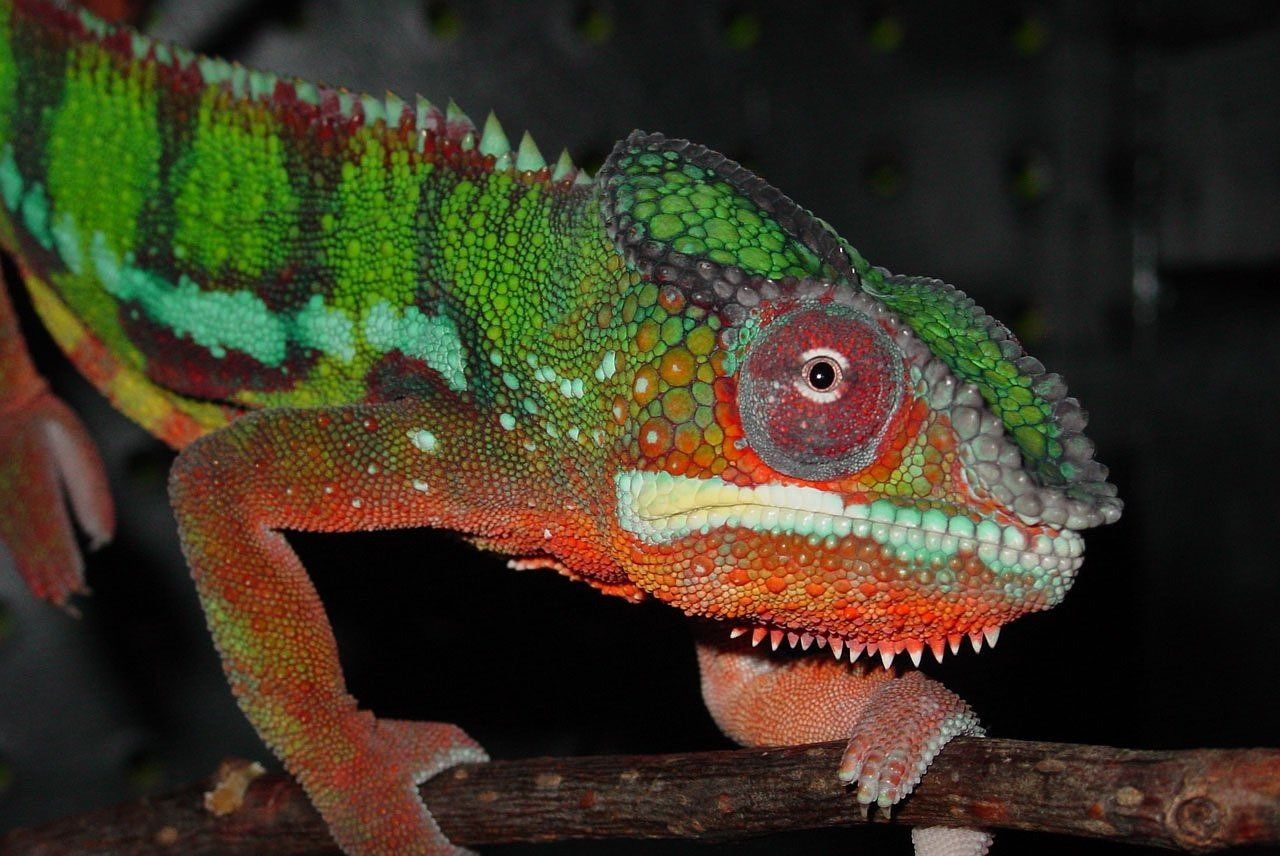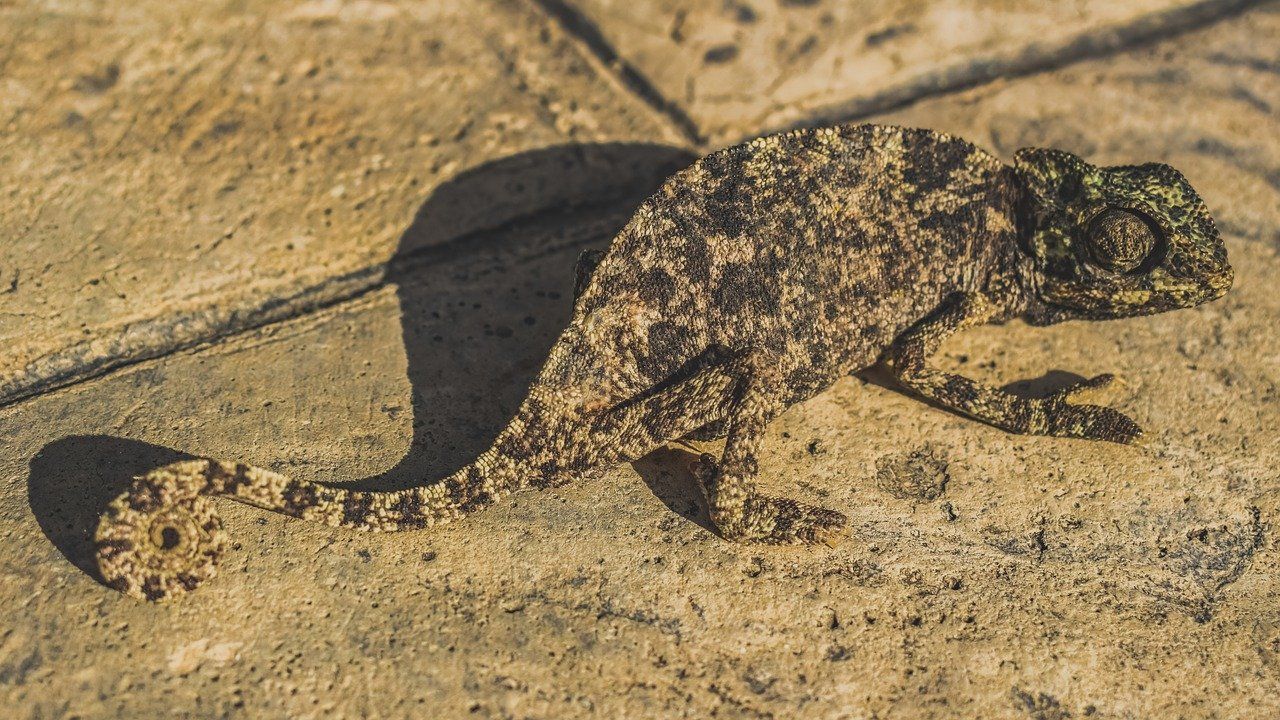Chameleons are curious creatures with some unusual features. There are over 150 species of this amazing reptile. Some are as small as a thumbnail while others are the size of a cat. Some chameleons live in warm habitats, ranging from deserts to rainforests.
Their neck is so short that they can’t turn their heads. They have large eyes which can move independently so that they can look forward and backward at the same time, providing a panoramic view of their surroundings.
They have sticky tongues which are 1.5 to 2 times longer than their bodies, and their tongue can dart out in a third of a second to catch insects.
Coat of many colours
However, the most unusual feature of chameleons – and the best known – is their ability to change colour. The normal colour of chameleons that dwell in rainforests is green and the usual colour of those that live in deserts is brown. But remarkably, they can vary their colour and pattern at will.
So how do chameleons manage to change colour? The outer layer of their skin is transparent while beneath it are layers of special cells filled with pigment – the substance that gives colour to plants and animals.

To display a particular colour, their brain sends a message to these colour-producing cells, which release pigments which can mix to create various colours as required. For instance, red and blue pigment may mix to make the chameleon look purple.
Amazing, isn’t it? The process by which they do this is complicated and not easy for even experts to fully comprehend.
The colour-changing ability of chameleons can be used for camouflage to protect these small reptiles from predators. Changing colour also helps chameleons regulate their body temperature. By turning darker, they absorb more light and heat, which helps warm them up, while turning lighter tends to cool them down.
They also change colour to communicate with other chameleons. They tend to show brighter colours when displaying aggression or to attract potential mates, but display darker colours to indicate submission.
Chameleon Christians
When the Israelites were about to enter the Promised Land, God directed Moses to give them instructions on how they should live in their new homeland. These instructions included avoiding eating certain animals which were to be regarded as unclean.
One of these animals was the chameleon (Leviticus 11:30). God’s command to avoid chameleons (among other animals) had a spiritual application for the Hebrews, reminding them that they were to be distinct from the various nations living around them. They were to be holy (Leviticus 11:44).
I believe there is a spiritual sense in which Christians today should avoid chameleons, so to speak.

At some point or other, most Christians face the temptation to change ‘colour’ to blend in with whatever background they happen to be in. It can be tempting to be just worldly enough to blend in with secular society, while just religious enough to fit in at church.
Against a worldly background, chameleon Christians may talk like the world, act like the world, and maybe even dress like the world. But in a Christian setting, they know how to behave accordingly.
This chameleon approach may be adopted due to timidity about standing out in a crowd or just plain weakness. Of course, attempts are made to justify it. Chameleon Christians don’t want to be uncomfortable and they don’t want to make anyone else feel uncomfortable either.
All things to all people?
The concept of changing ‘colour’ for the sake of blending in with the background is a trend of much of modern Christianity. Some common terms bandied about to justify this approach are ‘acceptance, inclusive, non-judgmental, and seeker-friendly’.
The reasoning is that by adapting ourselves to those around us, we can establish affinity and trust more easily. This may pave the way for an opportunity to share something of the gospel.
One Bible verse that might be cited is Paul’s words in 1 Corinthians 9:22-23, ‘I have become all things to all people, that by all means I might save some. I do it all for the sake of the gospel, that I may share with them in its blessings.’

These verses and their context need to be considered carefully. The apostle Paul was willing to condescend to the prejudices of all types of people – Jews, those under the law, those outside the law, and those who were ‘weak’. Paul would do this where it was lawful and in good conscience so that he could more easily explain the gospel to such groups.
But Paul never hid his loyalty to Christ. He was no chameleon Christian. He defended the gospel vigorously in front of all kinds of people.
Transformed, not conformed
Paul also wrote, ‘Do not be conformed to this world, but be transformed by the renewal of your mind, that by testing you may discern what is the will of God, what is good and acceptable and perfect’ (Romans 12:2).
God has called us to be transformed, not to be conformed to worldly standards. When we are transformed, we influence those around us to some degree wherever we go. But when we allow ourselves to be conformed to this world, those around us influence us. Whenever we find ourselves in an environment where we are tempted to change ‘colour’ in order to blend in, it is best to leave.
If you had the opportunity to see a chameleon, you wouldn’t know quite what colour it would be. It could be pink, blue, red, orange, green, black, brown, light blue, yellow, turquoise, or purple. If you saw it again, it might be a different colour. It might even be invisible to you if it had the same colours as the foliage around it.

Chameleons are amazing because they can blend into their environment. But Christians are to be different from unbelievers around us. We are the salt and light of this world (Matthew 5). We must not lose our saltiness and we cannot hide our light. We are to be holy (1 Peter 1).
Admire the amazing chameleons by all means, but don’t try to emulate their background-blending technique.
Bill Allan is deacon at Marshalswick Baptist Free Church.








